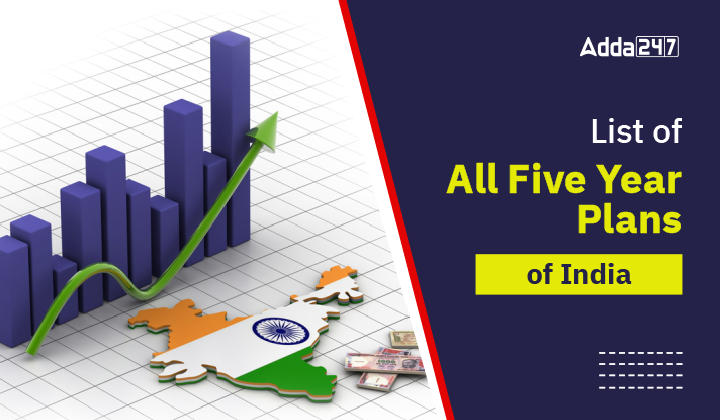Table of Contents
Five Year Plan in India was first launched in 1951. Since then, India has witnessed 12 different Five Year Plans with different objectives and results. The Five Year Plan in India were introduced and implemented to deal with economic challenges faced by India in the respective time frame.
In 2015, the current Narendra Modi Led government put the Five Year Plan in India to rest. The Five Year Plan in India has been replaced by a 15-year vision plan supported by 3-year action plans. According to the government, India needs a long-term vision for its growth and development in various sectors and fields. Read the following article to know more about the Five Year Plan in India in detail.
Five Year Plans in India
There were 12 Five Year Plan in India from 1951 to 2017. In the following table, the candidates will find all the information about the duration of the Five Year Plan in India along with the key assessment and objectives of these Five Year Plan in India.
| List of Five Year Plans in India | |||
| Five Year Plans | Years | Assessment | Objective |
| First Five year Plan | 1951- 1956 | Targets and objectives are more or less achieved. With an active role of the state in all economic sectors. Five Indian Institutes of Technology (IITs) were started as major technical institutions. | Rehabilitation of refugees, rapid agricultural development to achieve food self-sufficiency in the shortest possible time and control of inflation. |
| Second Five year Plan | 1956-1961 | It could not be implemented fully due to the shortage of foreign exchange. Targets had to be pruned. Yet, Hydroelectric power projects and five steel mills at Bhilai, Durgapur, and Rourkela were established. | The Nehru-Mahalanobis model was adopted. ‘Rapid industrialisation with particular emphasis on the development of basic and heavy industries Industrial Policy of 1956 accepted the establishment of a socialistic pattern of society as the goal of economic policy. |
| Third Five year Plan | 1961-1966 | Failure. Wars and droughts. Yet, Panchayat elections were started. State electricity boards and state secondary education boards were formed. | To Establish a self-reliant and self-generating economy in India |
| Plan Holidays – Annual Plans | 1966-1969 | A new agricultural strategy was implemented. It involved the distribution of high-yielding varieties of seeds, extensive use of fertilizers, exploitation of irrigation potential and soil conservation measures. | The crisis in agriculture and serious food shortage required attention |
| Fourth Five year Plan | 1969-1974 | Was ambitious. Failure. Achieved growth of 3.5% but was marred by Inflation. The Indira Gandhi government nationalized 14 major Indian banks and the Green Revolution in India advanced agriculture. | Growth with stability and progressive achievement of self-reliance Garibi HataoTarget: 5.5 pc |
| Fifth Five year Plan | 1974-1979 | High inflation. Was terminated by the Janta govt. Yet, the Indian national highway system was introduced for the first time. | Removal of poverty and attainment of self-reliance. |
| Sixth Five year Plan | 1980-1985 | Most targets achieved. Growth: 5.5 pc.Family planning was also expanded in order to prevent overpopulation. | The direct attack on the problem of poverty by creating conditions of an expanding economy |
| Seventh Five year Plan | 1985-1990 | With a growth rate of 6 pc, this plan was proved successful in spite of severe drought conditions for the first three years consecutively. This plan introduced programs like Jawahar Rozgar Yojana. | Emphasis on policies and programs that would accelerate the growth in foodgrains production, increase employment opportunities and raise productivity |
| Annual Plans | 1989-1991 | It was the beginning of privatization and liberalization in India. | No plan due to political uncertainties |
| Eighth Five year Plan | 1992-1997 | Partly success. An average annual growth rate of 6.78% against the target of 5.6% was achieved. | Rapid economic growth, high growth of agriculture and allied sector, and the manufacturing sector, growth in exports and imports, improvement in trade and current account deficit. to undertake an annual average growth of 5.6% |
| Ninth Five year Plan | 1997-2002 | It achieved a GDP growth rate of 5.4%, lower than the target. Yet, industrial growth was 4.5% which was higher than the targeted 3%. The service industry had a growth rate of 7.8%. An average annual growth rate of 6.7% was reached. | Quality of life, generation of productive employment, regional balance and self-reliance. Growth with social justice and equality. growth target 6.5% |
| Tenth Five year Plan | 2002 –2007 | It was successful in reducing the poverty ratio by 5%, increasing forest cover to 25%, increasing literacy rates to 75 % and the economic growth of the country by over 8%. | To achieve an 8% GDP growth rate, Reduce poverty by 5 points and increase the literacy rate in the country. |
| Eleventh Five year Plan | 2007-2012 | India has recorded an average annual economic growth rate of 8%, farm sector grew at an average rate of 3.7% as against the 4% targeted. The industry grew with an annual average growth of 7.2% against the 10% targeted. | Rapid and inclusive growth. Empowerment through education and skill development. Reduction of gender inequality. Environmental sustainability.
To increase the growth rate in agriculture, industry, and services to 4%,10% and 9% resp. Provide clean drinking water for all by 2009. |
| Twelfth Five year Plan | 2012-2017 | Its growth rate target was 8%. | “Faster, sustainable and more inclusive growth”. Raising agriculture output to 4%. Manufacturing sector growth to 10 %
The target of adding over 88,000 MW of power generation capacity. |
Five Year Plan in India
Every Five Year Plan in India came with its know set of objectives, purposes, and targets. It is very essential to read through the finer points of each Five Year Plan in India to understand it fully. Here is the detailed explanation and key points related to each Five Year Plan in India. Read carefully to understand the objective and actual growth achieved during these Five Year Plan in India.
First Five Year Plan
- The First Five Year Plan was presented by the First Prime Minister of India, Jawahar Lal Nehru from 1951 to 1956.
- The main focus of the First Five Year Plan was to develop the primary sectors like agriculture etc.
- During this phase, five IITs were set in the country.
- The Plan was based on the Harrod-Domar model with slight modifications.
Second Five Year Plan
- Under the leadership of Jawahar Lal Nehru, the Second Five Year Plan was also started from 1956 to 1961.
- The main focus of the Second Five Year Plan was to develop the Industrial sector of the country.
- According to the Government Report, the target growth rate of the Second Five Year Plan was 4.5% but they managed to achieve a 4.27% growth rate.
- However, based on the fact that India suffered a payment problem in 1957, the expert rejected the idea of achieving such high numbers of growth rates during the Second Five Year Plan.
- The Second Five Year Plan was created based on the P.C. Mahalanobis Model from 1953.
Third Five Year Plan
- This is the third consecutive Five Year Plan under the leadership of Jawahar Lal Nehru which was carried forward by Lal Bahadur Shastri after he became the Prime Minister.
- The primary focus of the Third Five Year Plan was to strengthen the economy of India and make it self-reliant and self-sufficient.
- Agriculture was hugely important for progress and self-sufficiency, thus the increase in wheat production was emphasised and under the leadership of Lal Bahadur Shastri, the Green Revolution was introduced.
- The plan was based on the model presented by D.R. Gadgil, the Deputy Chairman of the Planning Commission and therefore it was called the ‘Gadgil Yojana.
- As India went into 2 major Wars- the Sino-India conflict of 1962 and the Indo-Pakistani war of 1965- the economic weakness in the economy and defence sector of India.
- India lost the Sino-India War, there was price destabilization and India witnessed massive inflation as a result.
- Unfortunately, the Third Five Year Plan was a failure due to the wars and drought. The target growth was 5.6% however, India barely managed to achieve a 2.4% growth rate during the Third Five Year Plan.
Plan Holidays
- In response to the last failed Third Five Year Plan, the Indian Government came up with three annual plans between 1966 to 1969 and it was called the Plan Holidays.
- The plan focuses on economic development through emphasis on agriculture and all the related sectors.
- To boost the country’s export, a rupee devaluation was announced by the government.
Fourth Five Year Plan
- The Fourth Five Year Plan was introduced under the leadership of Indira Gandhi from 1969 to 1974.
- The Fourth Five Year Plan had two primary objectives- expansion with stability and gradual self-sufficiency.
- During Fourth Five Year Plan, 14 Major Indian Banks were nationalized and the Green Revolution was emphasized.
- The Fourth Five Year Plan is highly focused on family planning and population control programs.
- During the Fourth Five Year Plan, Pakistan waged war against India due to the conflict in Bangladesh (Then West Pakistan) which hampered the economic growth of India.
- Thus, the Fourth Five Year Plan fail miserably as it achieved only a 3.3% growth rate in comparison to the target growth rate of 5.7%.
Fifth Five Year Plan
- The Fifth Five Year Plan was introduced in 1974 and continued until 1978.
- The Fifth Five Year Plan was continued for only four years because in 1978 the newly appointed Morarji Desai Government discontinues the Fifth Five Year Plan.
- During the Fifth Five Year Plan, the Indira Gandhi Led government prioritized Garibi Hatao schemes, employment, justice, agricultural output and defence.
- India went through the “Emergency” period from 1975 to 1976.
- In 1975, the Indian National Highway System was established and Electricity Supply Act was changed. A Minimum Needs Program was introduced and Twenty-Point Program was established.
- In the parlance of growth rate, the Fifth Five Year Plan was a success, as India achieve a growth rate of 4.8% in comparison to the 4.4% target growth rate.
Rolling Plan
- Rolling Plan was introduced by the Morarji Desai Government in 1978. It was effective until 1980 when the Congress Government rejected it.
- The Plan had two phases- the initial 1-year phase where the annual budget was the main focus and the 2nd phase had no fixed amount of time frame.
- The main advantage of the Rolling Plan was that the Government had the flexibility to keep changing its priorities as per the current situation of the country. The target, projections and allocations were adjusted as per the conditions and circumstances.
Sixth Five Year Plan
- The Sixth Five Year Plan was executed under the leadership of Indira Gandhi from 1980 to 1985.
- The Sixth Five Year Plan was mainly focused on economic liberalization through creating technological self-sufficiency and eliminating poverty.
- The foundation for the plan was the infrastructure changes, Yojana investments and a growth model.
- The growth rate was targeted at 5.2% but the Sixth Five Year Plan managed to achieve a 5.7% growth rate.
Seventh Five Year Plan
- Rajiv Gandhi was the Prime Minister of the country when the Seventh Five Year Plan was executed from 1985 to 1990.
- The Plan focused on a self-sufficient economy, technological development and possibilities of gainful employment.
- The Seventh Five Year Plan completely focused on “food, word and productivity” to improve the output of the foodgrain, increase possibilities for employment and boost productivity.
- For the first time in the history of Independent India, the private sector gained more priority over the public sector.
- The Government achieved a 6.0% growth rate as compared to the target growth rate of 5.0%.
Annual Plans
Due to the volatile political scenario in India, there were two annual programs implemented for the years 1990-91 and 1991-92. These Annual Plans were executed to boost the Indian economy as it was opened for international trade and services.
Eighth Five Year Plan
- P.V. Narasimha Rao’s government executed the Eighth Five Year Plan from 1992 to 1997.
- The Eighth Five Year Plan led its primary focus on human resources such as education, employment and public health.
- During the Eighth Five Year Plan, the New Economic Policy of India was launched.
- This plan was a success, with an annual growth rate of 6.8% compared to the aim of 5.6.
Ninth Five-Year Plan
- The Ninth Five-Year Plan was started under the Leadership of Atal Bihari Vajpayee in 1997 and it lasted until 2002.
- “Growth with Social Justice and Equality” were the pillars on which the Ninth Five Year Plan stood.
- The Growth rate achieved was 5.6% in comparison to the 6.5% growth rate targeted for the Ninth Five Year Plan.
Tenth five-year plan
- The Tenth Five Year Plan lasted from 2002 to 2007 under the leadership of two Prime Ministers- Atal Bihari Vajpayee and Manmohan Singh.
- The goal of the Tenth Five Year Plan was to double India’s capita income in the coming next 10 years.
- The Tenth Five Year Plan aimed to cut down the poverty rate by 15% by the year 2012.
- It aimed for a growth rate as high s 8.0% but managed to achieve only 7.6%.
Eleventh Five-Year Plan
- Under the Prime Ministerial ‘ship of Manmohan Singh, the Eleventh Five Year Plan was executed from 2007-2012.
- The major focus point of the Eleventh Five Year Plan was to achieve rapid and more inclusive growth within the country.
- C. Rangarajan was responsible for preparing the Eleventh Five Year Plan.
- The growth rate achieve in the Eleventh Five Year Plan was 8.0%, though the target growth rate was 9%.
Twelfth Five-Year Plan
- Manmohan Singh was the head of the Twelfth Five Year Plan from 2012-2017.
- The goal was to achieve Faster Growth in an inclusive manner with sustainability.
Five Year Plan in India & the Growth Rate Report
Check out the target growth rate and achieved a growth rate of all the Five Year Plans in India in a nutshell.
| Five Year Plan in India & the Growth Rate Report | |||
| Five Year Plans | Years | Target Growth | Actual Growth |
| First Five year Plan | 1951- 1956 | 2.1% | 3.6% |
| Second Five year Plan | 1956-1961 | 4.5% | 4.3% |
| Third Five year Plan | 1961-1966 | 5.6% | 2.8% |
| Plan Holidays – Annual Plans | 1966-1969 | – | – |
| Fourth Five year Plan | 1969-1974 | 5.7% | 3.3% |
| Fifth Five year Plan | 1974-1979 | 4.4% | 4.8% |
| Sixth Five year Plan | 1980-1985 | 5.2 | 5.7 |
| Seventh Five year Plan | 1985-1990 | 5.0 | 6.0 |
| Annual Plans | 1989-1991 | – | – |
| Eighth Five year Plan | 1992-1997 | 5.6 | 6.8 |
| Ninth Five year Plan | 1997-2002 | 6.5 | 5.4 |
| Tenth Five year Plan | 2002 –2007 | 8.0 | 7.6 |
| Eleventh Five year Plan | 2007-2012 | 9.0 | 8.0 |
| Twelfth Five year Plan | 2012-2017 | 8.0 | – |
Five Year Plan in India & Key Points
- The Five Year Plans were Planned, Designed and Launched by Planning Commission from its inception on 15th March 1950.
- The First Five Year Plan was launched on 1st April 1951.
- The main objective of the Five Year Plan was to strengthen the economic backbone of India. As India attained independence in 1947 from oppressive British Rule, it was deemed necessary to plan the economic growth and development of the nation through these Five Year Plans.
- The Five Year Plan aimed at higher growth rates to improve the standard of living of the people of India along with economic stability, self-reliance, social justice, minimizing inequality and modernization to keep up with technological advancement and a better India.



 UGC NET Notification 2025 Out, Exam Date...
UGC NET Notification 2025 Out, Exam Date...
 UGC NET Application Form 2025 Starts for...
UGC NET Application Form 2025 Starts for...
 UGC NET Exam Pattern 2025 for Paper 1 an...
UGC NET Exam Pattern 2025 for Paper 1 an...














